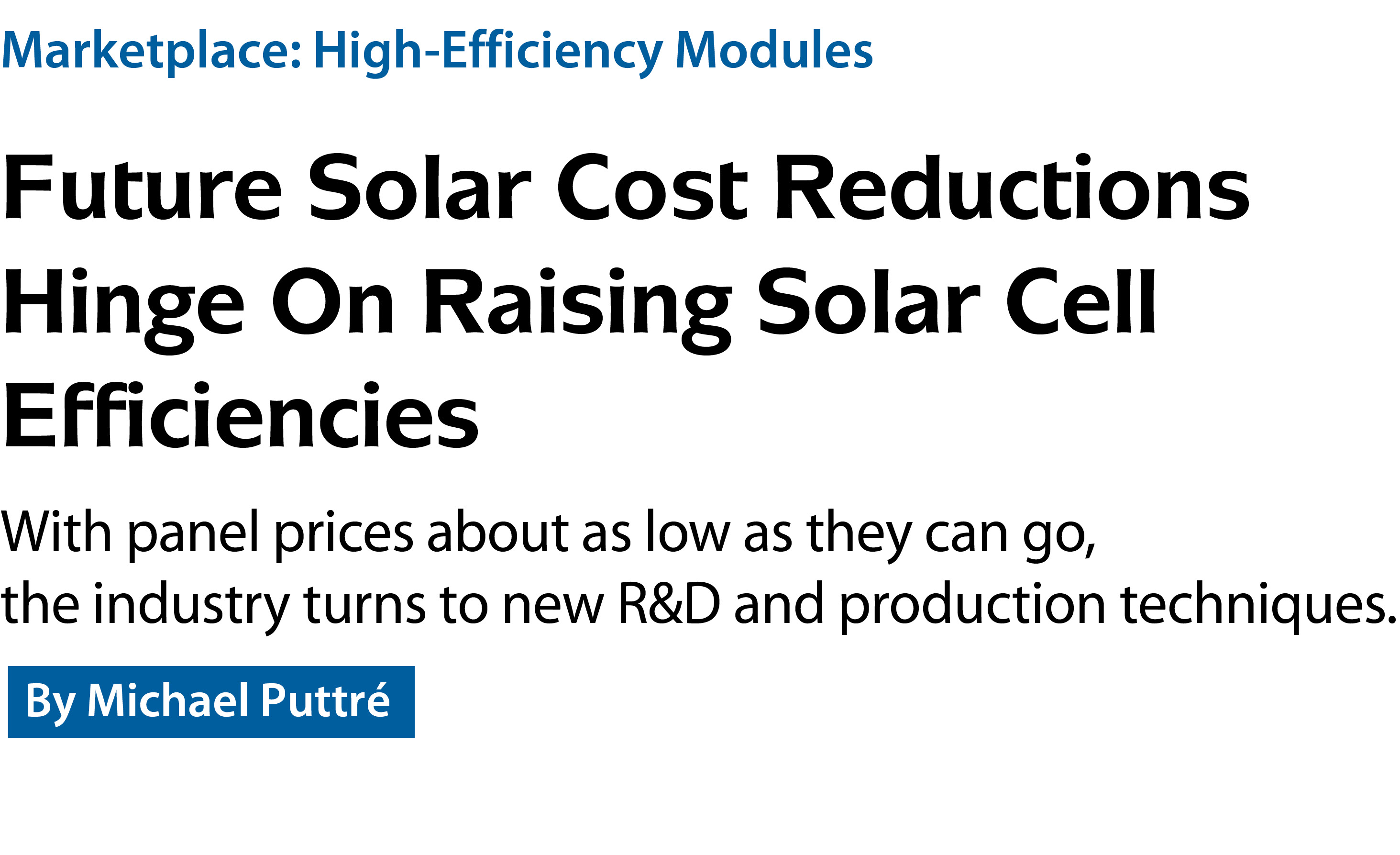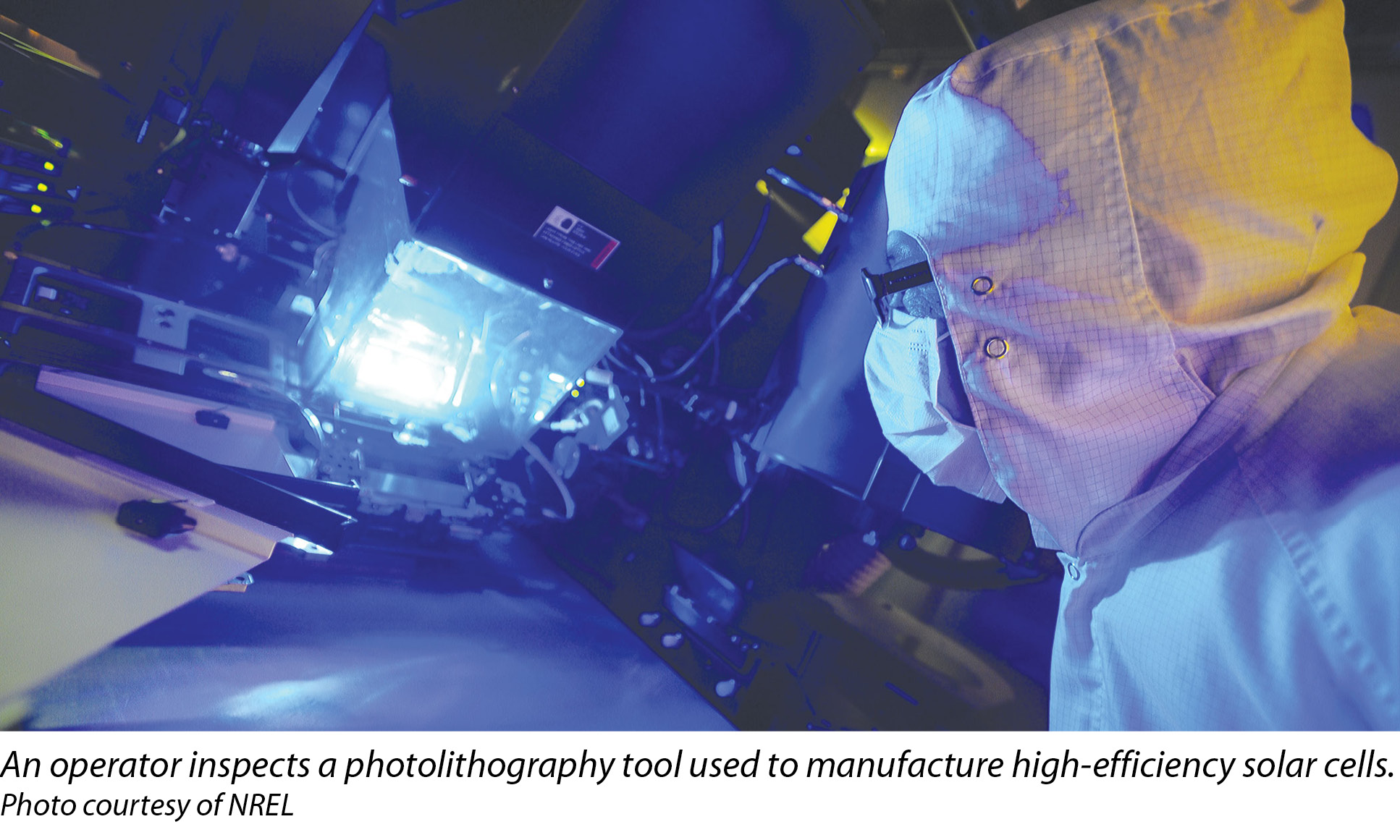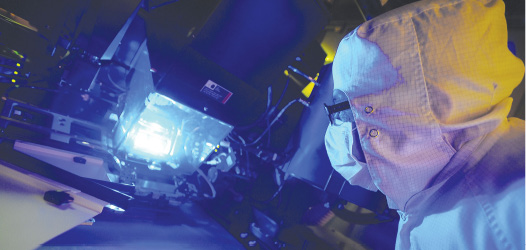

301 Moved Permanently
Lowering the levelized cost of energy (LCOE) of solar photovoltaic power is probably the No. 1 issue facing the industry. For most of the last decade, the focus of that effort has been reducing the costs of solar panels.
As profitability beckons, major PV manufacturers will be able to devote more resources to research and development (R&D). Increasingly, the focus of these efforts is on increasing the conversion efficiency and power output of PV modules.
“Higher efficiency is the best way to drive down your balance of system and labor costs because you have more watts with less pieces,” says Aaron Thurlow, vice president of global sales and marketing at California-based PV cell manufacturer Silevo. “With the cost of PV coming down, things that people did not think were important in the past, like logistics and transportation, actually become a bigger percentage of the total cost.”
Higher efficiency enables developers to install more watts in a given area. Alternately, a project can deliver a specified capacity with less land area, fewer support structures and lower labor costs.
SolarCity’s agreement to acquire Silevo and its plans for a “gigafactory” in upstate New York to manufacture the latter’s high-efficiency Triex modules represent a significant milestone in the movement to increase penetration of high-efficiency photovoltaic modules in the U.S. solar sector. At about 21%, Silevo’s production module cannot claim the highest conversion efficiency in the industry. However, because SolarCity plans to use all of the output from the new factory in the coming years, the influence of this union will be considerable.

Going higher
Silevo was founded in 2007 by two scientists, Zheng Xu and Jianming Fu, former executives at Applied Materials with backgrounds in semiconductor device structure, manufacturing and factory automation. The company founders worked under the concept that in order to advance the proliferation of solar energy and beat the cost of conventional grid power, the technology had to excel in efficiency, performance and overall cost structure.
Thurlow says the name “Triex” for the company’s flagship n-type module is essentially a marketing brand encompassing excellence in efficiency, performance and overall cost structure.
“If you want to move the needle in terms of solar photovoltaic technology, you need to excel in all three of these areas,” Thurlow says.
Silevo’s goal from the outset was to develop an architecture that was low cost. Thurlow says the company spent a lot of time working on removing silver from the solar cell, replacing it with copper wherever practical. Research also focused on lowering the number of process steps required and tailoring each process so it could be accomplished with off-the-shelf manufacturing tools.
“We have the n-type silicon, which gives us a good base foundation,” Thurlow says. “But we also have the amorphous silicon, which is a known material for performance in high-temperature environments. Heat is the enemy of efficiency.”
The use of n-type silicon is a departure from conventional p-type multicrystalline solar cells. Silevo is not alone in its use of n-type silicon, as other high-efficiency players in the industry also make use of n-type silicon in their cells and there is a growing trend in the industry toward n-type silicon.
On the yield side, by driving the temperature coefficient lower, a module is likely to generate more electricity per year in a hot climate. While modeling projected PV plant yields is not an exact science, Thurlow says the more sophisticated players in the industry are absolutely starting to pay attention to that. “If we look forward, more and more people are concerned about the yield advantage or disadvantage,” he says.
Getting to market
On a more fundamental level, the ability to cost-effectively produce high-efficiency model designs is what bridges the gap between ground-breaking research and commercial viability. According to Stephen Shea, chief engineering officer at Georgia-based Suniva, solar PV has to show itself to the marketplace as a cost-effective alternative to conventional power sources. This is not so much a bullseye as a situational condition.
“Our initial vision was to be able to compete in places where space is at a premium, such as rooftops and high-land-value sites,” Shea says. “But our belief is that we would be able to get costs down in a reasonable time frame to the point where we could compete with ground-mount, small commercial and more widespread applications.”
Suniva is seven years old, but its R&D roots go back to founder Ajeet Rohatgi’s work at Georgia Institute of Technology. The company is currently building a new production facility for its Optimus-series of modules in Michigan, with a planned annual capacity of 200 MW. The company already produces modules at its Norcross, Ga., facility on a smaller scale.
One of the keys to bringing research technology out of the university and into manufacturing is to be able to get as close to the manufacturing technique in the lab as possible. The research was always performed on full-size devices and with industrial-style processes.
“When we came to found Suniva in 2007, there was already a portfolio of intellectual property that had been developed at Georgia Tech that was directly applicable to high-efficiency industrial cells,” Shea says.
Suniva’s manufacturing equipment is all off-the-shelf. Shea says that equipment is put together in ways that permit a unique combination of materials and processes that enable them to tweak out extra efficiency. The advantage of this approach is that the company is able to produce higher-efficiency modules with essentially the same cost structure as conventional ones. This might be a modest point or point and a half, but it can make a difference in the marketplace.
The main differentiator from a technology perspective is the use of ion implantation to place dopant in the semiconductor. Shea says the technique allows very uniform placement of a dopant in precise patterns and depth. Suniva uses this process to replace the conventional gas-diffusion of phosphorous into a boron-doped substrate.
“Once you’ve got this figured out, it allows you to do tremendously repeatable dopant profiles,” Shea says. “This is a key to cost-effective efficiency improvement. We got a point just by trading out the gas diffusion.”
Ion implantation is common in the semiconductor industry. The knock on the approach for solar has been its expense. Suniva engaged in a two-year joint development with Varian Semiconductor to develop a high-throughput version of the process. Varian developed the machine, and Suniva developed the process that went with it.
“This has been the key to our high efficiency for about two-and-a-half years,” Shea says. “This also unlocks a bunch of engineering opportunities for reimagining the device and the process for further performance improvements and higher-efficiency devices.”
Moving forward
Shea says one of the major advantages of its location and pedigree is its status as a major customer of sponsored research out of Georgia Tech. Also, Suniva’s existing manufacturing facilities are able to serve up the physical components of research in a timely and cost-effective manner. An experiment that might have taken three weeks now takes 48 hours.
The direct connection between R&D and manufacturing enables a feedback loop that turns pure research - which has its merits - into something more than bragging rights.
“If you look at the industry of a few years ago, there was a lot of focus on champions and world records,” says Silevo’s Thurlow. “Our R&D has been focused on what can go into production. There are things that you can do to create a record that do not translate well into production.”
If a line of research would not translate easily into production, it is put aside. There is a company culture in the R&D team to move into pilot production. From there, the focus shifts to solving process issues standing in the way of going to full production.
“We have been very focused on production using proven techniques,” Thurlow says. “There are other technologies out there that have been successful at taking high concept into high efficiency in the marketplace. But it is a long path, and it is very costly.”
It was the demonstrable manufacturability of Silevo’s modules that attracted SolarCity as a buyer. Silevo currently has about 32 MW of manufacturing capacity from its facilities in China and claimed a pipeline of more than 250 MW of agreements in Europe, the U.S. and China prior to the announced acquisition.
“The economies of scale that we get from going to 1 GW will make this technology more cost-competitive,” Thurlow says.
At this point in time, SolarCity’s plan is to consume all of the output of the new Silevo factory, although this could change in a few years. Also, the acquisition does not freeze R&D at Silevo in time. The company says its current architecture has the ability to produce cells with a conversion efficiency of 24% without significant production changes.
“You always learn a lot about your product in R&D that becomes core intellectual property that we wouldn’t want to publicize,” Thurlow says. “However, the Triex cell, by nature of our process, is a bifacial cell. We’re evaluating the commercialization of bifacial modules that could give you additional energy harvest benefit in certain installations.”
Opportunities in the high-efficiency PV module market are attracting research firms seeking to commercialize their technologies rather than going into production themselves. U.K.-based Oxford PV has introduced a new application for its thin-film perovskite technology designed to boost the conversion efficiency of existing silicon solar cells by 20%.
“What we are building is known as a tandem solar cell, and it is not a new concept,” says Chris Case, chief technology officer at Oxford PV. “What is different is the specific use of our perovskite materials as the wide bandgap solar absorber on top of a conventional silicon solar cell.”
As Case describes it, the combination of a wider bandgap material - in this case, around 1.55 eV on top of silicon, which has a bandgap of 1.1 eV - allows a wider portion of the solar spectrum to be more efficiently converted into electricity. Published models show that an ideal stack of a perovskite solar material on top of silicon could have a conversion efficiency over 30%.
“It is even possible to have multiple layers of the perovskite, each tuned to a different part of the solar spectrum for even higher performance,” Case says.
Oxford PV is focused on two product commercialization routes. The first is building-integrated PV (BIPV), where the perovskite material is coated on glass to be incorporated into semi-transparent windows or opaque spandrels for large buildings. The second is the newly announced tandem cell.
“Both of these product areas use the same basic perovskite material so the challenges are the same to meet our development and pilot-scale activities,” Case says.
The company is currently demonstrating its materials using coating techniques that can cover substrates up to 30 cm wide. This is adequate to produce small glass window units that can be tested and shown to building and glass fabricating customers.
For the tandem product, Oxford PV is aiming to enable licensees to produce high-performance silicon cells and panels, where an absolute boost of perhaps 3% would allow them to offer panels at 25% efficiency.
Although solar investments have been quite toxic in the eyes of venture capital for several years, Case says the solar sector is ready for a new R&D drive to push the frontiers of PV conversion efficiency. PV is still only 2% of global energy supply, but the year-on-year growth continues to impress, and he expects a more normal R&D investment and business climate to return.
“R&D funding for PV is strong and increasing,” Case says. “This bodes well for the future, and I would expect that venture capital, business investment and deal flow will follow going forward. We have also been quite successful with obtaining grant funding from U.K. and European sources.” S
Marketplace: High-Efficiency Modules
Future Solar Cost Reductions Hinge On Raising Solar Cell Efficiencies
By Michael Puttré
With panel prices about as low as they can go, the industry turns to new R&D and production techniques.


si body si body i si body bi si body b
si depbio
- si bullets
si sh
si subhead
pullquote
si first graph
si sh no rule
si last graph